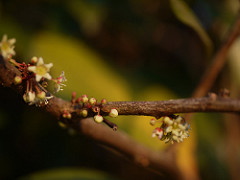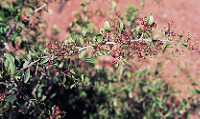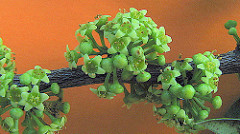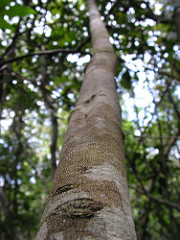Chuchuhuasi; Gnikélé

Chuchuhuasi, Chuchuhuasha, Chuchuaso and Gnikélé are common names within the genus of Maytenus used in traditional medicine. Studies have shown Maytenus' medicinal values for soothing nerve responses and for menstruation, as consistent with traditional use.
Etymology
Chuchuhuasi describes the species of Maytenus macrocarpa and possibly other species of Maytenus from the Amazon rainforest. Chuchuhuasha or Chuchuaso is the common name of Maytenus laevis. Gnikélé is the name of Maytenus senegalensis which is from the African continent.
The genus of Maytenus (Maytenus Spp.) was formerly recognized as Gymnosporia (Spp.).
Properties

Research has shown that the chemical pristimern from species of Maytenus slows the spread of breast cancer.
Use
For hormone balance

Chuchuhuasi (Maytenus) use is for menstrual cycle symptoms, and not necessarily directly for herbal breast enhancement.
Maytenus has anti-inflamatory, anti-spasm and pain relieving properties that assist with menstrual cramp pain (dysmenorrhea). This effect was shown in Gnikélé (Maytenus senegalensis) for its pain-relieving and anti-inflamatory effects. Maytenus rigida specifically demonstrated an anti-spasm effect. These effects seem common generally amongst species of Maytenus, as of how its use is described throughout traditional medicine.
The parts of Maytenus plants that are used are its bark and root.
Similar herbs

Also useful for reducing menstrual cramps are of the Viburnum genus: Cramp Bark (V. opulus) and Black Haw (V. prunifolium).
Precautions
See precautions for more details of care to be taken with herb use. Proper nutrition is a consideration for health. Also, check for the latest blog updates about herb and hormone safety.
It is very important that menses be light and not prolonged.
If you have hirsutism, PCOS, hot-flashes, other signs of hormone imbalances, see estrogen-imbalance, and hirsutism program journals at hirusitism-topic before trying herbs.
Herb concentrates can be tens of times more potent by weight than herbs in solid form. This can easily lead to hormone imbalances. For this reason, concentrate extracts are not recommended for extended or excessive internal use, especially during fertility years. Concentrates shouldn't be used to overcome plateaus. Another issue with herbal extracts, is that they may not have the full range of properties of the herb. Essential oils are not recommended for breast enhancement. If opting to use herbal extracts, use food grade extracts, with no more than 1 drop at a time diluted in water.
More


For the latest herb programs and how to get started, see: guide. Pictures of breast enhancement can be seen in the program journals of Anon02, Anon08, Anon09, Bubblemelon and Jellie.
For resources on hips and butt enhancement, see: /appendix/hips-butt-enhancement and /appendix/kettlebell.
breast-endocrinology.pdf describes the science of breast development and endocrinology. It also describes symptoms related to hormone imbalances. Biology and hormone imbalances are excerpts from this ebook. breast-endocrinology.pdf uses a Creative Commons (CC BY-ND 4.0) license.
Breast.is blog
References:
- Medicinal Plants Traditionally Used in Mali for Dysmenorrhea. https://www.ncbi.nlm.nih.gov/pmc/articles/PMC3252716/.
- Antispasmodic effect of 4'-methylepigallocatechin on guinea pig ileum. https://www.ncbi.nlm.nih.gov/pubmed/22626748.
- Chuchuhuasha - a drug used in folk medicine in the Amazonian and Andean areas. A chemical study of Maytenus laevis. https://www.ncbi.nlm.nih.gov/pubmed/7033668.
- Pristimerin inhibits breast cancer cell migration by up- regulating regulator of G protein signaling 4 expression. https://www.ncbi.nlm.nih.gov/pubmed/22799288.
Etymology & Definitions:
- The Plant List: Maytenus. http://www.theplantlist.org/1.1/browse/A/Celastraceae/Maytenus/.
